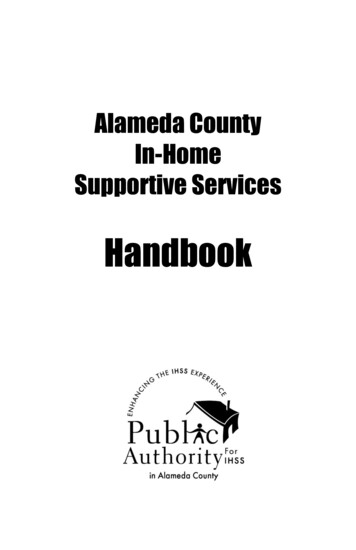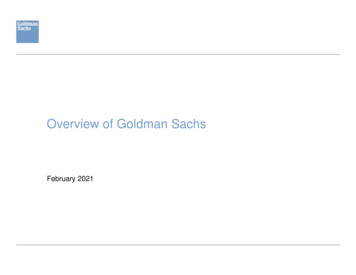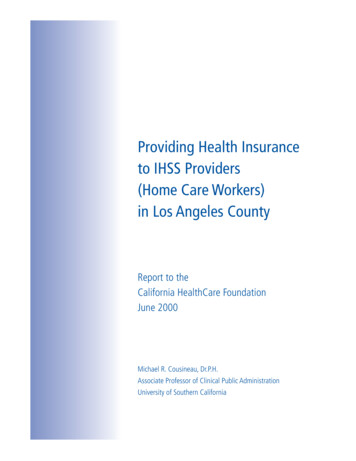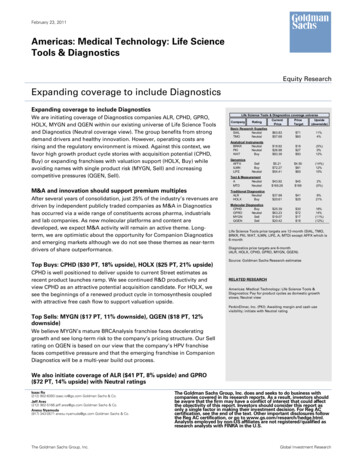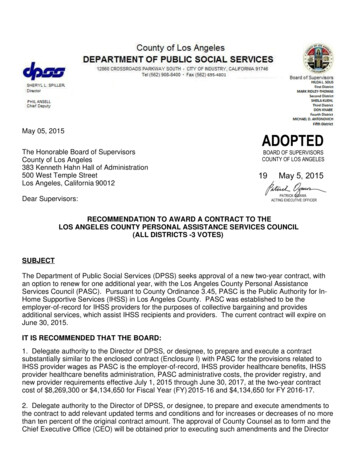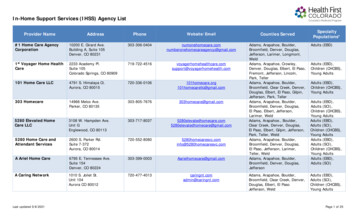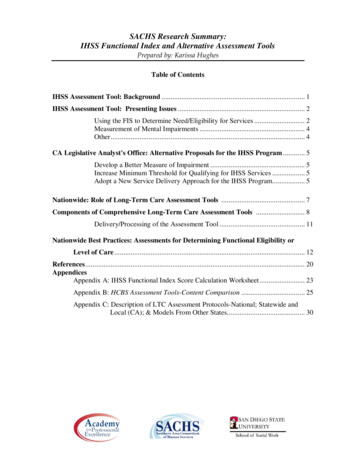
Transcription
SACHS Research Summary:IHSS Functional Index and Alternative Assessment ToolsPrepared by: Karissa HughesTable of ContentsIHSS Assessment Tool: Background . 1IHSS Assessment Tool: Presenting Issues . 2Using the FIS to Determine Need/Eligibility for Services . 2Measurement of Mental Impairments . 4Other . 4CA Legislative Analyst's Office: Alternative Proposals for the IHSS Program . 5Develop a Better Measure of Impairment . 5Increase Minimum Threshold for Qualifying for IHSS Services . 5Adopt a New Service Delivery Approach for the IHSS Program. 5Nationwide: Role of Long-Term Care Assessment Tools . 7Components of Comprehensive Long-Term Care Assessment Tools . 8Delivery/Processing of the Assessment Tool . 11Nationwide Best Practices: Assessments for Determining Functional Eligibility orLevel of Care . 12References . 20AppendicesAppendix A: IHSS Functional Index Score Calculation Worksheet . 23Appendix B: HCBS Assessment Tools-Content Comparison . 25Appendix C: Description of LTC Assessment Protocols-National; Statewide andLocal (CA); & Models From Other States. 30
SACHS Summary: IHSS Functional Index and Alternative Assessment ToolsIHSS ASSESSMENT TOOL: BACKGROUND In 1988, fifteen years after the IHSS program was created, the State legislature passeda law requiring CDSS to develop a uniform needs assessment tool “to assure that inhome supportive services are delivered in all counties in a uniform manner” (Cal.Welf. & Inst. Code § 12309(a)). In response, CDSS developed and implemented aUniformity Assessment System. As part of the Uniformity Assessment System, theState created the Functional Index (FI) Score in 1988 to use in rating elderly ordisabled individuals’ functional abilities. Each recipient is given an overall FI Score(FIS) between 1.00 and 5.00. There are two separate processes that produce the final FIS: first, the social worker’sassessment of the physical and mental limitations of a client; and second, a computergenerated calculation to produce an overall FIS. The social worker’s assessmentprovides a Functional Limitation Ranking (FLR) for each of 14 tasks in terms of needfor human assistance. There are 11 separate areas of physical functioning (fourhousehold tasks: housework, laundry, shopping and meal preparation; and sevenpersonal tasks: mobility, bathing, dressing, bowel, bladder and menstrual, transfer,eating and respiration) and three separate areas of mental functioning (memory,orientation and judgment). However, the calculation of the FIS does not include theFLRs given for the client’s mental limitations and need for protective supervision orany FLRs that indicate a paramedical need. The calculation is based solely on aweighted average of the 11 areas of physical functioning (See Appendix A-IHSSFunctional Index Score Calculation Worksheet). (Wallace, Valentine, Smith, et al.,2009) IHSS employs a social model rather than a medical model. Services are determinedby assessments done periodically by a county worker who rates the ability of eligibleapplicants to perform a range of specific living tasks considered essential to maintainindependence, rather than medical criteria. The social model focuses on activities ofdaily living and the IHSS client’s ability to function in his or her own home. Themedical model assesses clients based on medical deficits. (CWDA, 2003) Those who qualify for IHSS are persons “who are unable to perform the servicesthemselves and who cannot safely remain in their homes or abodes of their ownchoosing unless these services are provided” (Welf. & Inst. Code § 12300(a)). TheCDSS Manual of Policies and Procedures (MPP) similarly directs that IHSS“provides assistance to those eligible aged, blind and disabled individuals who areunable to remain safely in their own homes without this assistance” (MPP § 30700.1). Therefore by definition, an individual given a FIS of two through five in anyof the functions have already been determined by the worker to need some IHSSassistance to remain safely in his or her own home. In 1994, a study by the Institute for Social Research addressed the question ofreliability, validity, and variability in California’s IHSS functional assessments andauthorized hours. The tool was found to be highly reliable by teams of independent1
SACHS Summary: IHSS Functional Index and Alternative Assessment Toolsevaluators in a sample of 1,432 clients. Evidence clearly demonstrated that theassessment tool can be applied in a very consistent manner by a well-trained staff. Asexpected, assessed hours increase directly with increase in functioning rank for alltasks, indicating validity of the tool. County average FI scores varied. (Barnes, 1994) Since 2005, the State of California has spent 10 million providing eight days oftraining to over 16,000 social workers who conduct IHSS assessments.(V.L., et al., Plaintiffs, v. John A Wagner, 2009)IHSS ASSESSMENT TOOL: PRESENTING ISSUESUsing the FIS to Determine Need/Eligibility for Services California’s FI rankings and the composite FI Scores were not designed to, and donot, measure individual need or eligibility. In fact, one key argument in the federalcase which enjoined the state from implementing a targeted reduction was that FIscores were an inadequate measure of impairment or risk of institutionalization(LAO, 2010). Rather, “the purpose of the ranks was to help social workers determinewith uniformity the number of hours of a particular service elderly and disabledindividuals needed.” And the composite FI Scores were to be used for aggregatecomparison of FI Scores and authorized hours on a county or statewide basis, not onan individual basis. Neither had ever been used to measure individual eligibility.Thus, using the FI rankings to determine eligibility would result in the arbitrarywithdrawal of services. (IHSS Coalition, 2010) Key informants identify this as a poor method of identifying those with the least needand see it as too complex to implement. Appeals of the scores by those who losebenefits can slow the entire eligibility system. Those with cognitive impairments andthose without family support or an outside advocate are the least likely to have theresources to appeal and may be the first to feel the service reductions. (Wallace,Benjamin, Villa, & Pourat , 2009) The current assessment inaccurately equates the length of time a task normally takeswith the importance of the task to an individual’s health and safety. The FI Scoringsystem favors elderly and disabled people with many different needs, especially needsfor help with tasks that are particularly time-intensive, over those with fewer differentneeds, and needs for help with tasks that are less time-intensive, even though theunmet needs of some of the latter recipients may be equally or more life-threateningthan those of the former. For example, an elderly person who needs help with taskswhich on average are less time-consuming, such as mobility inside the home, transferfrom sitting to standing or respiration, is more likely to receive a lower FI Score andlose all services, than is one who needs help with the kinds of tasks that tend to takemore time, such as meal preparation. (V.L., et al., Plaintiffs, v. John A Wagner, 2009) The FIS does not weigh the critical nature of the services recipients need and itsystematically disadvantages certain groups of recipients. If a person with a particular2
SACHS Summary: IHSS Functional Index and Alternative Assessment Toolstype of disability does not need assistance with most activities, but critically needssubstantial assistance with a few, he or she will likely receive a low FI Score, andcould be deprived of all IHSS services. (V.L., et al., Plaintiffs, v. John A Wagner,2009) As previously mentioned, while the FLRs do assess the physical and mentallimitations of a client, the computer generated calculation of the FIS does not includethe full range of disability ratings assessed. The average FIS does not include ratingsof the mental limitation areas, or the most severe rating for any area. Consequently,the FIS if used to determine eligibility inadequately captures those who are limited bytheir mental functioning to carry out household and personal tasks. This oversightwould place some older adults with impaired cognitive functioning at great risk ofinjury and institutionalization. In addition, an IHSS recipient may lose hours if theyscore too low on any of the four domestic assistance tasks. For example, a recipientwho is able to reheat meals but not prepare them will lose all hours allowed for mealpreparation since they need “some” but not “a lot” of assistance (3.5 to 7 hours perweek). (Wallace, Benjamin, Villa, & Pourat , 2009) The elimination of domestic and related services for individuals with functional indexranks below 4.00 will be very detrimental. Domestic services are in some respects the“glue” that permits older people to stay in their homes. Shopping and mealpreparation are especially essential, since they influence how much and how wellolder people eat. Weight loss is an indicator for families that a loved one is notsucceeding at home, especially those living alone, and can lead to what one observerhas predicted will be families thinking sooner about nursing home placement.(V.L., et al., Plaintiffs, v. John A Wagner, 2009) The FIS is particularly inaccurate as a measure of the needs of children andadolescents. Because children, with or without disabilities, are not generally expectedto perform such tasks as meal preparation and housecleaning, children withdisabilities are automatically ranked at one on such tasks. This rank reflects, not theseverity of their disabilities, but only the expectations of their age group. The dummyscores equal to “one,” carries a negative weight, which statistically impacts theclient’s overall FIS. It would make more sense if this was coded instead as an N/A soduring scoring it did not lower the client's FIS and services. Children’s andadolescents’ critical needs, though fewer in number, will not be met, merely becausethey do not have as many unmet needs as adults with the same level of disability.(V.L., et al., Plaintiffs, v. John A Wagner, 2009) The “comparability” requirement of the Medicaid Act mandates comparable servicesfor individuals with comparable needs and is violated when some recipients aretreated differently than others where each has the same level of need (42 U.S.C. §1396a(a)(10)(B); see also 42 C.F.R. § 440.240). The state may “place appropriatelimits on a service based on such criteria as medical necessity or on utilization controlprocedures.” However, the state may not “arbitrarily deny or reduce the amount,duration, or scope of a required service . . . to an otherwise eligible recipient solelybecause of the diagnosis, type of illness, or condition” (42 C.F.R. § 440.230(c)(1-2)).3
SACHS Summary: IHSS Functional Index and Alternative Assessment ToolsThe use of numerical ranks and FI Scores to determine eligibility for IHSS serviceslikely violates the comparability requirement of the Medicaid Act because neitherreasonably measures the individual need of a disabled or elderly person for aparticular service. (V.L., et al., Plaintiffs, v. John A Wagner, 2009)Measurements of Mental Impairment Numerical ranks are particularly inaccurate measures of the needs of individuals withmental impairments, such as elders with Alzheimer’s disease. Individuals withcognitive and psychiatric disabilities frequently require verbal rather than physicalassistance. Therefore, many of these individuals receive numerical ranks of two ratherthan three or four. Numerical ranks of two for recipients with mental disabilitiesreflect the nature of the assistance needed, not the severity of the need. Disabled andelderly individuals with numerical ranks of two have no less need for verbalassistance than individuals with severe physical impairments have for physicalassistance. For example, elders may need reminders to eat on a regular basis, takemedication or avoid eating foods contraindicated with certain medications.(V.L., et al., Plaintiffs, v. John A Wagner, 2009) Individuals with mental disabilities may need only a few critical services, such asmedication management and assistance with domestic and related tasks. But, becausethey do not need help with a larger number of personal care functions such asbowel/bladder, ambulation or respiration, their FI Scores will generally be below 2.0.Nevertheless, individuals with mental impairments are no less in need of IHSSservices than those with physical impairments. (V.L., et al., Plaintiffs, v. John AWagner, 2009)Other The IHSS assessment tool does not contain items that assess individual preference forliving arrangement. Nor does it identify family opposition or any potential difficultiesin meeting the client’s preference. (Osterweil, et al., 2008) When documenting hours, shared living exceptions are included, which has thepotential to reduce the level of household services to recipients who live withsomeone else. These reductions are not based on an individual’s needs for service,that is, it does not consider whether a recipient lived with someone who actuallywould help. (V.L., et al., Plaintiffs, v. John A Wagner, 2009) Designed to be used by programs that target specific populations, within the contextof a specific program (IHSS) and at this stage cannot reasonably be used for otherpopulations. The information collected via the IHSS Assessment is also more difficultto share across providers. This limited-use tool can create duplication andfragmentation within a system and often subject individuals to multiple assessmentsto obtain needed services. (Osterweil, et al., 2008)4
SACHS Summary: IHSS Functional Index and Alternative Assessment ToolsCA LEGISLATIVE ANALYST'S OFFICE (LAO): ALTERNATIVE PROPOSALSFOR THE IHSS PROGRAMDevelop a Better Measure of Impairment The LAO (2010) believes a better assessment measure for the IHSS Program shouldbe developed for two reasons:o First, it will better enable the Legislature to target services to those most atrisk of institutionalization.o Second, it will strengthen the state’s position with respect to legal challengesin federal court. The LAO recommends enactment of legislation requiring DSS to present theLegislature with a new system of measuring impairment and the risk of institutionalplacement no later than January 10, 2011.o In developing the new measures, DSS should be directed to convene at leasttwo stakeholder meetings including, but not be limited to, providerorganizations, consumer organizations, social workers who conductassessments, county representatives, and legislative staff.o The new system for measuring impairment should require that a socialworker make a specific finding whether the client needs IHSS services inorder to avoid institutional placement. (Legislative Analyst Office, 2010)Increase Minimum Threshold for Qualifying for IHSS Services One option the Legislature could consider to better target the program would be toraise the minimum threshold for qualifying for IHSS services. For example, each taskcould have a different minimum FI ranking that would be required to receive theparticular task. Recipients could be required to have a FI ranking of at least 4 toreceive authorization for dressing assistance, but only a 3 to receive authorization forbathing assistance.o By increasing the minimum ranking for qualification, services would betargeted to those with the highest impairment levels for those particular tasks.o The LAO notes that the use of FI rankings and scores as a method fortargeting IHSS services is currently being challenged in court. However, thereare other ways to target services, such as making certain services onlyavailable to recipients who are authorized to receive a certain minimumnumber of hours, or requiring that the client receives developmental disabilityservices or is certified for SNF placement to qualify for particular services.(Legislative Analyst Office, 2010)Adopt a New Service Delivery Approach for the IHSS Program IHSS program consists of a diverse caseload with varying levels of need. As a result,it may make sense to construct a program that recognizes the variation in the needs ofdifferent segments of the caseload, and provides different types of servicesaccordingly to each segment.o For example, under this approach, the more frail recipients could continuereceiving IHSS, while other recipients could instead receive funds to purchasegoods and services to assist them in remaining in their own homes.5
SACHS Summary: IHSS Functional Index and Alternative Assessment Tools The LAO proposed a new three-tiered service-delivery approach to delivering IHSSwhich would be based on determined hours versus FIS ranking. Service levels wouldbe correlated to the new measure of impairment and risk. Such an approach couldprovide a continuum of care which would help all Californians delay or avoid theneed to enter an institution while better targeting services to those with the greatestimpairment. The three different tiers of available services based on the recipient’soverall level of need could be as follows:1. First Tier: Recipients in the first tier would be the most frail recipients (in thisexample, the severely impaired with over 195 authorized hours per month) forwhom services would remain unchanged.2. Second Tier: Recipients in the second tier could receive a variation on cash andcounseling services, with authorization to spend a set allocation of funds on thepurchase of goods and services, such as in-home care or home modifications, suchas a wheelchair ramp, to assist them in remaining in their own home. Tier tworecipients would also receive increased case management and other assistancefrom their IHSS social worker.3. Third Tier: Recipients in the third tier would receive no IHSS services and noallocation of funds. Instead, these recipients would receive quarterly visits from asocial worker who would monitor the condition of the recipient and provide casemanagement services. The intent of monitoring this group would be to transferthem to tier one or two if their condition met the qualification levels of those tiers.Severely-impaired recipients(195 hours of care permonth).Affected RecipientsTier One—Recipients with atleast 195 authorized hours permonth.IHSS Policy ChangeNo ChangeNon-severely impairedrecipients (less than 195 hoursof care per month).Tier Two—Recipients withbetween 80 and 194authorized hours per month.Provide (1) cash for purchaseof goods and services and (2)increased case management.Tier Three—Recipientswith between 1 and79 authorized hoursper month.No IHSS or cash assistance.Increased social worker casemanagement. The LAO example bases the tiers on the number of authorized hours, but theLegislature could consider basing the tiers on other factors related to the level ofrecipient need. The Legislature could also consider creating additional service tiers.6
SACHS Summary: IHSS Functional Index and Alternative Assessment Tools Such a major reform to the IHSS program would require legislative input on manydetails, and likely require significant changes to the current Medicaid State Plan andwaiver agreements with the federal government. However, a tiered approach toservice delivery could more effectively target resources to those with the highest riskof SNF placement. (LAO, 2010)o This new IHSS service-delivery proposal by LAO has similarities toVermont’s Choices for Care Program (introduced in October 2005, usinga 1115 waiver) which uses a clinical assessment to prioritize clients(individuals 18 and older with disabilities, including the frail elderly) intotwo tiers based on their levels of need for long-term services. Clients with the highest level of need are in the first tier and areeligible for a nursing facility or HCBS. People categorized as“highest need” were entitled to either nursing home or HCBS ifthey met the following criteria: have severe cognitive limitations orrequire extensive or total assistance with toileting, bed mobility,eating, or transferring; and have a monthly income of less thanabout 2,000 and assets worth less than 2,000 (for nursing homecare) or 5,000 (for HCBS). Clients in the second tier, “Moderate Need” do not qualify forinstitutional care, as they are individuals who have beendetermined to need minimal assistance to remain at home, but theyare eligible for limited case management, adult day services, and/or homemaker service. The availability of services depends on the availability of funds,however. Similarly, the state has permission to create waiting listsfor the “High Need” group if necessary for budgetary reasons. Under Choices for Care, the state can combine HCBS funds withnursing home funds in a single capitated global budget. For more information, on Vermont’s Choices for Care Programsee: -cfc/(Shirk, 2009)NATIONWIDE: ROLE OF LONG-TERM CARE (LTC) ASSESSMENT TOOLS Number of Americans needing long-term care services: nearly 13 millionNumber of nursing home residents: 1.8 millionNumber receiving home- and community-based services (HCBS): 10.9 millionNumber of people receiving unpaid help from family and friends: 9.8 millionNumber of people receiving HCBS who get paid help: 1.4 million(Kaye, Harrington & LaPlante, 2010) Assessment tools can help to ensure accurate and consistent findings across clientsand assessors. It can also provide a mechanism for the state to ensure that only needed7
SACHS Summary: IHSS Functional Index and Alternative Assessment Toolsservices are authorized. The assessment process varies across states, influenced bymany factors, including state organizational structures, available programs, andadministrative requirements, such as level-of care determinations and authorization ofservices. (Shirk, 2009) As the Medicaid LTC programs have grown, states have examined methods forcontrolling LTC costs and ensuring appropriate utilization via the use of clientassessment tools. Under federal Medicaid guidelines, states have flexibility indetermining the need for LTC services because the minimum need criteria are notspecified in statutes or regulations. (Tonner & Harrington, 2004) Assessment is a fundamental part of the medical care process and the social service –planning process. It provides a systematic approach to collecting information anddistilling it into a coherent framework. In contrast to clinical care, the actions in LTCare often less aggressive and less directed toward the goal of cure or evenrehabilitation. They are more likely to be compensatory, in the sense of helping theclient adjust to reduced circumstances—restrictions created by illness andenvironment. (Kane & Kane, 2000) In addition to identifying needs for the purpose of developing service plans,assessments can serve other functions, including determining functional (sometimesreferred to as “medical”) eligibility, establishing a budget for services or allocating acertain number of service hours, and monitoring quality. (Howes, 2010) The need for assistance with instrumental activities of daily living (IADLs), the needfor supervision, and the lack of formal and informal support are measures used morefrequently in evaluations for community-based services than for institutional services.(Summer, 2007) In their assessment tools, states use a variety of terms in addition to “level-of-care”criteria, including health and functional criteria, need criteria, targeting criteria, andservice criteria. (Summer, 2007) Another use for assessments is to determine a client’s priority level for services. Moststates have waiting lists for their HCBS waiver programs, and the assessment resultscan help establish where the client will fall on the waiting list. (Shirk, 2009)COMPONENTS OF COMPREHENSIVE LTC ASSESSMENT TOOLS A well-designed assessment instrument identifies the full range of a client’s serviceneeds so that they can be addressed when possible, thus preventing or delaying theneed for institutionalization. Assessments are generally considered by experts to becomprehensive when they cover six domains:1. Physical Health8
SACHS Summary: IHSS Functional Index and Alternative Assessment Tools2. Mental Health3. Functioning4. Social Resources5. Economic Resources6. Physical EnvironmentMost state assessment instruments address all domains to some extent; however, thereis wide variability in the depth to which each domain is examined.(U.S. General Accounting Office, 1996; Shirk, 2009) Such an assessment must include psychological and social status, because therecommendations and decisions of case management teams are often more likely toinfluence psychosocial outcomes than physical health outcomes. (Kane & Kane,2000) Setting level-of-care criteria poses a challenge for states. Criteria that are too broadmay be problematic if the size of the population qualifying for services cannot besupported by available resources. Long waiting lists may be anticipated. On the otherhand, if restrictive criteria are used, some very needy individuals may not have accessat all to needed services. Some of the important questions states must consider whenstates establish the criteria and the process to determine functional eligibility include:o How should functional eligibility or “level-of-care” be determined? What criteria should be used? Should the same process be used to assess functional eligibility forall service settings? Should states use more than one level of care? Who should conduct assessments for functional eligibility? What kind of training should be provided?(Summer, 2007) Incorporate deliberate thoughtful assessments of both the client’s status (and impliedprognosis) and the values attached to possible alternative outcomes to enhance thisvital process and produce results that are as compatible as possible with client andfamily goals. There is a sore need for a simple, pragmatic way to allow clients andfamilies to explore how they value alternative outcomes relative to each other. Workalong these lines has shown, for example, that clients and providers do not place thesame relative value on ADLs and IADLs. Clients place more importance on IADLs,whereas providers emphasize ADLs. (Kane & Kane, 2000) Make assessment more client-centered by incorporating more information about theperson’s strengths and preferences. These types of questions are particularlyimportant when the assessment is used for younger individuals with disabilities whowant to exercise more control over their daily lives. (Shirk, 2009) All comprehensive assessments evaluate informal supports. Evaluating informal caregiving helps ensure that services in the care plan do not duplicate services that arealready being provided by someone else. (Shirk, 2009)9
SACHS Summary: IHSS Functional Index and Alternative Assessment Tools Include elements within the tool that evaluate the caregiver’s status. This can be doneby explicitly examining issues such as caregiver stress, health, and ability to continueproviding informal supports, or including a rating or code that indicates the level ofinformal support that is available-which are then considered when developing theservice plan. (Shirk, 2009) Most experts believe that adopting one standard assessment tool regardless of theclient’s age, disability, geographic region or services needed, encourages moreobjective screening of medical and functional needs and is more equitable forbeneficiaries. Another argument for developing uniform assessment procedures forHCBS waiver programs and nursing facilities is that administrative efficiencyimproves. Duplication of effort occurs when clients must complete more than oneapplication for different types of long-term services and multiple administrators mustreview applications. (Summer, 2007) Assessments that are designed to serve multiple functions appear to create more clientfriendly systems that reduce the need for repeated contacts and redundant questions.As states move toward providing more services in the community, issues such asclient strengths and preferences and caregiver status have taken on more importance.(Shirk, 2009) It is generally easier to collect data from casual reports that summarize observationsover time than from specifically structured observation or performance done in acontrolled study. Moreover, these two approaches can tap different aspects ofbehavior. From the standpoint of enhancing reliability, there are advantages to testingclients whenever possible under standardized conditions. For example, ADLfunctions may be demonstrated by asking a client to actually eat something (e.g. aspoonful of raisins or water) or to dress, using a standardized garment. Occupationaltherapists routinely test clients in standardized kitchens and bathrooms. (Kane &Kane, 2000) There is some evidence to suggest that older persons with significant limitations inseveral IADLs, such as shopping, meal preparation, house cleaning, andtransportation,
SACHS Summary: IHSS Functional Index and Alternative Assessment Tools 1 . a law requiring CDSS to develop a uniform needs assessment tool "to assure that in-home supportive services are delivered in all counties in a uniform manner" (Cal. . assistance to remain safely in his or her own home. In 1994, a study by the Institute for Social .
